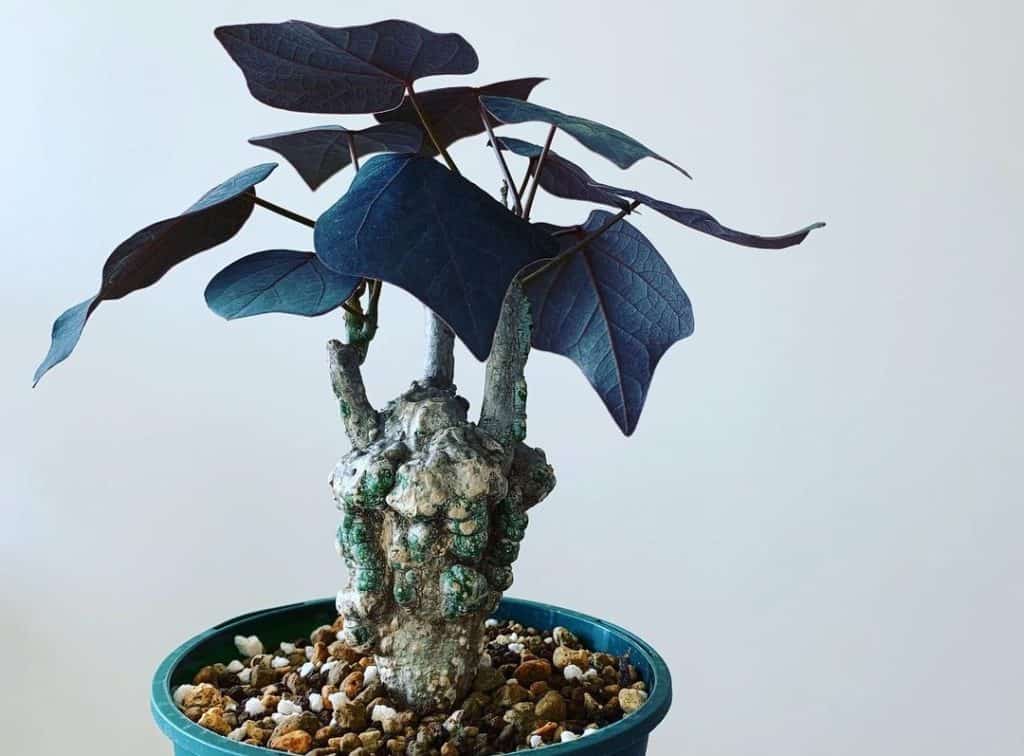Adenia stylosa: The Twisted Beauty from Madagascar
Imagine a plant so peculiar, so enchantingly bizarre, that it seems plucked straight from the pages of a fantasy novel. Meet Adenia stylosa, the candlestick plant, a captivating succulent native to the rugged landscapes of northern Madagascar. With its twisted, candelabra-like stems and eerie moniker, the “purple vine of evil,” this botanical wonder is sure to pique the curiosity of even the most seasoned plant enthusiasts. So, let’s delve into the fascinating world of Adenia stylosa and unravel its enigmatic allure.

About Adenia stylosa
Belonging to the Passifloraceae family, Adenia stylosa is a shrub-like succulent adorned with a remarkable thick, green caudex (the swollen base of the stem) that resembles an otherworldly candle. From this extraordinary base, several contorted stems emerge, each adorned with striking purple-green leaves featuring prominent crimson veins, creating a mesmerizing contrast against the plant’s overall verdant hue.
Related Post:
1,000 Types of Succulents [With Pictures]
How to Care for Adenia stylosa
Light Requirements
Adenia stylosa thrives in bright, sunny conditions, basking in 5 to 8 hours of direct sunlight each day. However, during the hottest parts of the day, it’s best to provide some shade to prevent scorching. If you’re cultivating this beauty indoors, a grow light can mimic the intensity of natural sunlight, ensuring your plant receives the radiance it craves.
Watering
Like most succulents, Adenia stylosa prefers a “soak and dry” watering approach. During the growing season, water thoroughly, allowing the soil to dry out between waterings. Check the top few inches of soil, and when it feels dry to the touch, it’s time to quench your plant’s thirst again. Reduce watering frequency to about once every 1-2 weeks during the cooler months when the plant enters dormancy.

Soil Preferences
To thrive, Adenia stylosa requires a well-draining, gritty soil mix rich in nutrients and with a slightly acidic pH. A specialized succulent or cactus potting mix is an excellent choice, but you can also create your own blend by mixing in materials like pumice stone for aeration and perlite for moisture retention.
Fertilizing for Optimal Growth
During the spring and summer growing season, feed your Adenia stylosa with a succulent- or cacti-friendly fertilizer every 2-3 weeks. This will provide the essential nutrients it needs to flourish. As the cooler months approach and the plant enters dormancy, suspend fertilizing until the following spring.
Temperature and Humidity
Adenia stylosa revels in warm, bright conditions, with an ideal growing temperature around 70°F (21°C). While it can tolerate elevated temperatures, it’s not frost-hardy and should be brought indoors during fall and winter if you live in cooler regions (USDA hardiness zones below 11a-11b). As for humidity, average household levels are typically sufficient for this resilient plant.

Pests and Problems
While Adenia stylosa is generally pest-resistant, it’s still wise to keep an eye out for common plant pests like mealybugs and spider mites, especially during the active growing season. If an infestation occurs, a strong spray from the hose can dislodge many pests, followed by appropriate treatment measures.
Overwatering is a common issue that can lead to fungal or bacterial diseases, so proper drainage and allowing the soil to dry out between waterings is crucial. Watch for signs of disease, such as leaf spots, and address them promptly.
Pruning and Maintenance
Adenia stylosa doesn’t require frequent pruning, but you can remove any wilted or dying leaves for aesthetic purposes. Exercise caution when pruning, as the plant contains a poisonous sap and prickly thorns – wear gloves to protect your skin.
Potting and Repotting
Repotting your Adenia stylosa is typically only necessary every 2-3 years during the growing season or when the roots begin to protrude from the pot, indicating the need for more space.
Adenia stylosa Propagation Methods

Adenia stylosa can be propagated through both seeds and stem cuttings, allowing you to expand your collection of this fascinating plant with relative ease. However, the preferred method often varies depending on your intended purpose for the new plants.
Seed Propagation:
Growing Adenia stylosa from seeds is the recommended approach if your goal is to cultivate decorative specimens with well-developed caudices (the swollen stem bases). Here are the steps to follow:
- Sow the seeds during the growing season, as this will give them the best chance of successful germination and establishment.
- Prepare a well-draining seed-starting mix and moisten it before sowing the seeds.
- Cover the seeds with a thin layer of the seed-starting mix, not exceeding their thickness.
- Maintain consistent moisture levels, but be careful not to overwater.
- Provide bright, indirect light and warm temperatures around 70-80°F (21-27°C).
- Be patient, as Adenia stylosa grown from seed can take several years to develop their distinctive caudices.
Stem Cutting Propagation:
While plants propagated from stem cuttings may not develop as impressive caudices, this method is preferred for those interested in seed production, as these plants tend to bloom more freely. Here’s how to propagate Adenia stylosa from stem cuttings:
- Take a healthy stem cutting, making a clean cut just below a node (the point where leaves emerge).
- Optionally, dip the cut end in a rooting hormone to encourage root development.
- Plant the cutting in a well-draining rooting medium.
- Keep the rooting medium moist but not waterlogged.
- Once roots emerge and the cutting is well-established, transplant it into a potting mix suitable for succulents.
Regardless of the propagation method you choose, providing the right growing conditions, such as ample light, appropriate watering, and well-draining soil, will be crucial for the successful establishment of your new Adenia stylosa plants.
